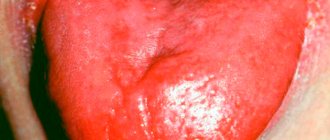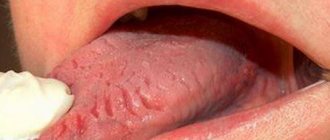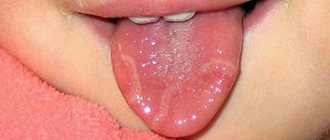Many parents notice with alarm that the child’s tongue is undergoing changes - it suddenly changes its normal color, begins to peel and peel. Why do such changes occur, do they represent a serious pathology, and what treatment is required?
Geographic tongue, which is also known as desquamative glossitis, is a disease of an inflammatory-dystrophic nature, accompanied by external changes in the mucous surface of the tongue. This disease does not have any “age limits” - it can occur with equal frequency in adults and newborns. Most often, geographic tongue is diagnosed completely by accident, at a regular dentist appointment.
What is desquamative glossitis
As noted above, a geographic pattern on a child’s tongue is, in most cases, nothing more than desquamative glossitis. What is this? Inflammatory-dystrophic disease of the mucous membrane of the tongue. It is accompanied by desquamation (desquamation) and keratinization of the epithelium, dystrophic changes in the taste buds, which together lead to the appearance of “blurring” spots on the surface of the muscular organ. The disease is considered benign, but nevertheless may indicate certain problems in the body, which we will talk about later.
Inflammatory diseases of the tongue are combined into one broad group and are called “glossitis”. Read about this pathology and its varieties here.
Diagnosis and treatment of geographic tongue in an adult
Diagnosis of the disease in most cases does not cause difficulties. The diagnosis is made after a thorough examination and history. In some cases, consultation with a dentist and gastroenterologist will be required.
When making a diagnosis in adults, an extensive examination is necessary. When collecting anamnesis, the presence of chronic diseases and allergic manifestations, as well as the state of the immune system, is taken into account. Taking all this into account, the doctor will prescribe a course of treatment for geographic tongue in an adult and monitor its implementation.
Symptoms that signal pathology
The pathology can go unnoticed for a very long time, since there are no pronounced symptoms and subjective sensations. It is most often noticed not by parents or close relatives, but by pediatricians during preventive examinations or dentists, if necessary, to carry out treatment in the mouth. To understand what geographic tongue looks like in children, see the photo.
Examples of geographic language in children
With sufficient awareness of this disease, it is possible to identify it at home. As a rule, glossitis of this form is localized on the back and lateral surfaces of the organ. At first, a single spot in the form of an oval or ring may appear on one of these areas, but then other formations appear. Then they can merge with each other. The spots themselves are pinkish at first, and then become bright red. Around them is a border of gray-white rim.
“I accidentally saw this in my daughter’s mouth. At first they thought it was a burn, but the baby didn’t complain about anything at all, nothing hurt at all. Not capricious. We didn’t go to the doctor right away; after a while everything went away on its own. And six months later, such a bad thing came out again. We have already started scouring the Internet and found pictures with a geographical language exactly like our hare’s. We made an appointment with a pediatrician, but she sent me to a gastroenterologist, although she said that there was nothing wrong, it was just that perhaps the renewal of the daughter’s epithelium was uneven. But isn’t this normal?
A fragment of a review from the babyblog.ru forum
The lesions alternate with healthy mucous membranes that are not affected by the inflammatory process, and it all looks like geographical spots on a child’s tongue. In this case, deepithelialization, that is, desquamation or detachment of the epithelium from the affected areas is quickly replaced (within 1-3 days) by epithelization. Another important point is that foci of desquamation can migrate, change shape, size, location, and therefore the pathology is sometimes called migratory glossitis.
Important! With this pathology, sometimes there are complaints of burning, soreness, tingling or numbness in the area of the muscle organ. Dry mucous membranes may be bothersome. Discomfort may occur when eating acidic foods (tomatoes, pineapples, plums, citrus fruits). However, the sensations are not clearly expressed, so only older children, for example, teenagers, can adequately evaluate them and tell adults about them.
How to help a child with a stuck tongue?
- The first and most important thing is to calm the baby so that he does not twitch or try to tear off his tongue or lip on his own to avoid injury. Hug, reassure, tell that nothing bad is happening and you will help.
- The metal needs to be heated. The ideal way is with a warm drink from a thermos (this is not uncommon - mothers often take a thermos with them on walks). Pour a thin stream onto the metal surface in the area in contact with the baby's skin. The metal will heat up quickly, and the tongue will come off without injury.
- If there is no hot liquid nearby, warm the metal surface by breathing. Explain to your child how to breathe correctly: close your nose and exhale through your mouth. By warming the surface, you can slowly release the child's tongue, avoiding significant injury. It will take more time, but it will help.
Causes and factors provoking the disease
Many scientists admit that geographic tongue is a disease, the causes of which have not been fully elucidated. Most often, it is a kind of symptom indicating pathologies of the gastrointestinal tract and hematopoietic system, endocrine and autonomic disorders, helminthic infestations and viral infections.
Symptoms of geographic tongue
When a geographic tongue appears in a child, the reasons may also lie in dysbiosis and vitamin deficiency, poor nutrition, and long-term antibiotic therapy. Often the factors that provoke the development of the disease are injuries to a muscle organ, acute allergies to anything, diseases of the oral cavity (including caries, candidiasis) and inflammatory phenomena during teething.
Forms of the disease
According to some literature, experts distinguish several types of desquamative glossitis:
- neurogenic: accompanied by neurological symptoms, neuroses, stuttering, decreased saliva secretion,
- allergic: in clinical practice it is often observed in combination with urticaria, diathesis, rhinitis, drug, food and pollen allergies,
- candidiasis: with it, characteristic spots on the muscular organ are often adjacent to plaque, in which, upon examination, fungi of the genus Candida are found,
- dysbiotic or microbial: with it, as with the candida variety, there may be a general deterioration in health, an increase in body temperature,
- mixed: usually combines allergic and candidiasis factors.
Diagnostic features
If, based on the results of a visual examination, you or the doctor have discovered geographic spots on the child’s tongue, then it is necessary, first of all, to find out the true cause of the pathology. After all, the mucous membrane will fully recover only when the correct treatment is performed.
What are the main methods for diagnosing the disease?
It is important to comprehensively examine the body. The doctor needs to collect an anamnesis to know about the young patient’s previous illnesses and living conditions. Next, you need to get tested. What tests should be taken to determine the pathology that caused a child’s geographic tongue?
Usually these are general blood tests, stool, urine tests, and smears for enterobiasis. Biochemistry may be required for specific markers of various diseases. Specialists will also take scrapings or smears to determine the composition of the microflora and identify viruses, fungi and parasites. You may need to be examined by an endocrinologist, neurologist, gastroenterologist, cardiologist, including the use of ultrasound.
Treatment of pathology
Drug therapy is aimed at eliminating the underlying cause. Geographic tongue is not an independent disease, but a condition that signals serious problems in the body.
Additional events:
- sanitation of the oral cavity;
- exclusion of salty, spicy and hot foods from the diet;
- alkaline rinses, local applications with anesthetic;
- prescription of antihistamines;
- prescription of multivitamin complexes.
If you strictly follow the doctor’s recommendations, the prognosis for the disease is favorable.
Traditional medicine recommends using oak bark decoction, calendula or chamomile decoction as rinses. You can also use propolis (applied to the affected areas), vegetable oil (oral baths) and honey.
To treat or not to treat: doctors' opinion
It is interesting that some experts consider desquamative glossitis to be a normal variant or a feature of the body. Especially if it appears in childhood and during puberty. And then doctors only offer wait-and-see tactics and observation, claiming that sooner or later everything will go away on its own. But this, of course, is only provided that a comprehensive examination of the body has been carried out and no causes have been identified.
Expert opinion
Alina Vyacheslavovna Fedulova
Specializations: Dentist-therapist, hygienist
Experience: 6+
“Geographic language in itself is not dangerous in a child or adult. Does not contribute to the deterioration of well-being, does not affect the quality of life (only from a psychological point of view). It does not degenerate into oncology and is not considered contagious. In many children, it tends to go away on its own, so it is not always treated if the cause has not been established and all possible factors have been excluded. However, sometimes the cause that provokes the appearance of desquamative glossitis can pose a threat to the body, and therefore this symptom obliges adults to conduct a comprehensive examination of the child and, if necessary, undergo specific treatment.”
Complications and prevention
Geographic tongue is not an independent disease, but its appearance signals serious disturbances in the functioning of the body. The sooner you contact a specialist, the sooner adequate treatment will be prescribed. Timely therapy is a guarantee of a high-quality cure for the disease.
In childhood, complications are very rare.
Preventive actions. Fighting bad habits, taking vitamins in the spring and autumn, adequate treatment of gastrointestinal diseases and timely sanitation of the oral cavity will help avoid this condition.
Book a consultation with our specialists and find out how to treat geographic tongue disease.
Possible options for general and local treatment
The attending physician will best tell you what to do if your child has a geographic tongue in each specific case. Some doctors still classify desquamative glossitis as a group of acute inflammatory[2] diseases, especially if concomitant factors have been identified. Therefore, general and local symptomatic therapy is prescribed to eliminate problems that lead to the appearance of an unpleasant symptom.
General treatment
It is carried out jointly with dentists, allergists, endocrinologists and other specialists through whose line the pathologies were identified. Typically includes the following set of measures:
- sanitation of the oral cavity: removal of plaque, treatment and removal of diseased teeth, restoration of damaged and missing row units,
- taking sedatives: for the neurogenic form of desquamative glossitis, patients are often prescribed motherwort and valerian, Novopassit, Persen. Also, in severe cases, tranquilizers and nootropic drugs, for example, glycine, pantogam,
What to take to treat geographic tongue
- taking detoxification drugs: Enterosgel, Filtrum, activated carbon and others,
- identification and treatment of somatic diseases: prescribing anti-inflammatory, antifungal or antibacterial drugs appropriate to the situation,
- taking desensitizing (antihistamine) drugs: “Tavegil”, “Suprastin” and others,
- taking vitamins and calcium pantothenate, as well as immunomodulators.
Symptoms of geographic tongue
The main symptoms of desquamative glossitis are visible to the naked eye, so most often diagnosing the disease does not cause any particular difficulties. In the vast majority of cases, geographic tongue refers to painless pathologies - the disease is not accompanied by any complaints or painful sensations.
The appearance of the geographic tongue exactly corresponds to its name - whitish stripes, grooves and spots appear on the mucous surface of the tongue, which visually resemble a geographical map. The sizes of such spots can be very different - from several millimeters to centimeters. Most often, such lesions are multiple, and in extremely rare cases - single.
At the initial stages of the disease, the spots are small in size, but quickly begin to grow, merging with each other and creating larger spots.
The appearance of a geographic tongue in some cases may be accompanied by a feeling of discomfort, itching and tingling on the surface of the tongue, especially these unpleasant sensations intensify during meals. When eating too hot or cold, sour, spicy or salty foods, a person may experience disturbances in the sensitivity of the tongue, up to a complete loss of taste.









